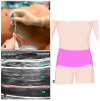Non-Neuraxial Chest and Abdominal Wall Regional Anesthesia for Intensive Care Physicians-A Narrative Review
- PMID: 38398416
- PMCID: PMC10889232
- DOI: 10.3390/jcm13041104
Non-Neuraxial Chest and Abdominal Wall Regional Anesthesia for Intensive Care Physicians-A Narrative Review
Abstract
Multi-modal analgesic strategies, including regional anesthesia techniques, have been shown to contribute to a reduction in the use of opioids and associated side effects in the perioperative setting. Consequently, those so-called multi-modal approaches are recommended and have become the state of the art in perioperative medicine. In the majority of intensive care units (ICUs), however, mono-modal opioid-based analgesic strategies are still the standard of care. The evidence guiding the application of regional anesthesia in the ICU is scarce because possible complications, especially associated with neuraxial regional anesthesia techniques, are often feared in critically ill patients. However, chest and abdominal wall analgesia in particular is often insufficiently treated by opioid-based analgesic regimes. This review summarizes the available evidence and gives recommendations for peripheral regional analgesia approaches as valuable complements in the repertoire of intensive care physicians' analgesic portfolios.
Keywords: ICU; abdominal wall blocks; airway blocks; chest wall blocks; peripheral nerve blocks; regional anesthesia.
Conflict of interest statement
The authors declare no conflicts of interest.
Figures





Similar articles
-
The Role of Regional Anesthesia in ICU Pain Management.Curr Pain Headache Rep. 2025 Jan 8;29(1):21. doi: 10.1007/s11916-024-01328-1. Curr Pain Headache Rep. 2025. PMID: 39777576 Review.
-
Challenges of the Regional Anesthetic Techniques in Intensive Care Units - A Narrative Review.J Crit Care Med (Targu Mures). 2024 Jul 31;10(3):198-208. doi: 10.2478/jccm-2024-0023. eCollection 2024 Jul. J Crit Care Med (Targu Mures). 2024. PMID: 39108409 Free PMC article. Review.
-
Regional Analgesia for Cesarean Delivery: A Narrative Review Toward Enhancing Outcomes in Parturients.J Pain Res. 2023 Nov 10;16:3807-3835. doi: 10.2147/JPR.S428332. eCollection 2023. J Pain Res. 2023. PMID: 38026463 Free PMC article. Review.
-
Chest Wall Nerve Blocks for Cardiothoracic, Breast Surgery, and Rib-Related Pain.Curr Pain Headache Rep. 2022 Jan;26(1):43-56. doi: 10.1007/s11916-022-01001-5. Epub 2022 Jan 28. Curr Pain Headache Rep. 2022. PMID: 35089532 Review.
-
Regional Analgesia for Cardiac Surgery Part 1. Current status of neuraxial and paravertebral blocks for adult cardiac surgery.Semin Cardiothorac Vasc Anesth. 2021 Dec;25(4):252-264. doi: 10.1177/10892532211023337. Epub 2021 Jun 23. Semin Cardiothorac Vasc Anesth. 2021. PMID: 34162252
Cited by
-
Why we should insist on education about and implementation of ultrasound-guided regional anesthesia in intensive care units.Croat Med J. 2025 Jul 5;66(3):231-234. doi: 10.3325/cmj.2025.66.231. Croat Med J. 2025. PMID: 40635345 Free PMC article. No abstract available.
-
Fascial plane blocks in the era of modern regional anesthesia: shaping the future of pain management.J Anesth Analg Crit Care. 2025 Jul 25;5(1):49. doi: 10.1186/s44158-025-00269-4. J Anesth Analg Crit Care. 2025. PMID: 40713771 Free PMC article. No abstract available.
References
-
- Chanques G., Sebbane M., Barbotte E., Viel E., Eledjam J.J., Jaber S. A prospective study of pain at rest: Incidence and characteristics of an unrecognized symptom in surgical and trauma versus medical intensive care unit patients. Anesthesiology. 2007;107:858–860. doi: 10.1097/01.anes.0000287211.98642.51. - DOI - PubMed
-
- Turan A., Leung S., Bajracharya G.R., Babazade R., Barnes T., Schacham Y.N., Mao G., Zimmerman N., Ruetzler K., Maheshwari K., et al. Acute Postoperative Pain Is Associated With Myocardial Injury After Noncardiac Surgery. Anesth. Analg. 2020;131:822–829. doi: 10.1213/ANE.0000000000005033. - DOI - PubMed
Publication types
LinkOut - more resources
Full Text Sources

